Bradford
Explore hidden histories, historic photos, and things you never knew about Bradford from the collections and archives of Historic England.
Discover your local listed buildings and places
Introducing some of Bradford's most historic sites, included in the National Heritage List for England. Some of these captions have been summarised by AI. Click through for the official List entry. Skip this section and go to place by numbers
Ilkley Lido (Including Cafe and Changing Rooms)
Ilkley
Lido. 1934-5 by Mr A Skinner, Ilkley Urban District Borough Surveyor. Concrete, brick, sandstone dressings, plywood, timber, and felt tiles.
Former Richard Dunn Sports Centre
Bradford
A local sports and leisure centre, built 1974-1978, by Trevor Skempton of the Bradford City Architects department with consulting engineers White, Young and partners.
Lund Park
Keighley
Lund Park, opened in 1891, is a 6.1ha public park in Keighley, featuring sports facilities and gardens. It was gifted by James Lund and includes historical architectural elements.
'Story of Wool' sculptural mural, International Developme…
Ilkley
Sculptural mural. 1968 by William Mitchell for the International Wool Secretariat. Bronze-faced glass reinforced plastic (GRP).
Dalton Mills, all attached buildings and yard surface
Keighley
A mill complex of 1866-77 for the manufacture of worsted cloth, now in multiple use.
Scholemoor Cemetery
Bradford
A public cemetery designed by the Borough Surveyor, Charles Gott, opened in 1860 and extended in the early-C20 with a crematorium designed by the Borough Architect, F E P Edwards.
Saltaire
Baildon
The official listing for all World Heritage sites is held by UNESCO and can be found on their website.
Site of Roman Fort, Ilkley.
Ilkley
Ilkley Roman fort, built from AD 43, was strategically located in northern England and shows Roman and Anglo-Saxon remains.
Knowle Mill
Keighley
Knowle Mill is a former worsted textile mill constructed in two phases in the early twentieth century, built in stone with slate roofs and currently in multiple use.
St Ives Estate
Bingley
A two-phase C19 designed landscape associated with an early C19 mansion and its C17 predecessor.
Whinburn
Keighley
Whinburn, built in 1897, was a mansion with gardens laid out by T H Mawson. It housed Prince Smith III and became a training center post-1940, then a school until 2002.
Keighley Drill Hall
Keighley
Drill Hall opened 1867, designed by Messers John Judson and More, Keighley for the 35th West Yorkshire Volunteer Corps, extended 1876 and 1897.
Heathcote, subsidiary buildings and structures, and entra…
Ilkley
House, subsidiary buildings and structures, and entrance walls. 1906-8 by Edwin Lutyens. Guiseley sandstone with Morley ashlar dressings, red Roman pantile roofs.
Bradford Synagogue (Reform)
Bradford
Synagogue. 1880-1. Islamic Revival style by Francis and Thomas Healey. Yellow ashlar stone with bands of red ashlar stone from Siena. Slate roof. Red brick to 1956 school room extension.
Bingley Station, including the south-west platform walkwa…
Bingley
Railway station, 1892, by Charles Trubshaw for the Midland Railway, in neo-Renaissance style.
Ukrainian Autocephalic Orthodox Church
Bradford
Ukrainian Autocephalic Orthodox Church, formerly Eccleshill Methodist Chapel, 1854-1855, by James Simpson of Leeds, Italianate style.
WW2 Pillbox and 2 Fire Posts South of Former Royal Ordnan…
Steeton with Eastburn
A pillbox and two fire posts, sited in a field to the south of a former Royal Ordnance Factory, the fire posts in the south-west (fire post 2) and south-east (fire post 1) corners of the...
Lister Park
Bradford
Lister Park, created between 1870-1904, features late 19th-century structures, a museum, art gallery, and a Mughal garden, offering rich cultural and historical significance.
Prince of Wales Park
Bingley
Prince of Wales Park in Bingley opened in 1865, featuring woodland gardens, heathland, and pathways. It is named after the Prince of Wales whose wedding day marked its founding.
Late prehistoric enclosed settlement with an outlying ban…
Addingham
Late prehistoric enclosed settlement on Counter Hill is an important example of upland exploitation, illustrating settlement types from the Late Bronze Age to Romano-British period.
Keighley War Memorial
Keighley
War memorialErected 1924 by Keighley Municipal BoroughBronze sculpture by Henry FehrJ W Singer and Sons founders.
Twelve Apostles stone circle, Burley Moor
Burley
The Twelve Apostles stone circle on Rombalds Moor showcases prehistoric ritual significance, featuring irregularly spaced stones and an earthen bank, despite modern damage and adjustments.
Heathcote, Ilkley
Ilkley
Heathcote, designed by Sir Edwin Lutyens with gardening by Gertrude Jekyll, is a formal garden with Italianate style, situated in Ilkley, built in 1906-8.
New Beehive Inn
Bradford
Public house, 1901 by JH Cox. Built from stone with a slate roof and retaining its original interior plan and a number of elements of the original interior decorative scheme.
Bowling Park
Bradford
Bowling Park, established in 1880, features entrances from Bowling Park Road and Drive, a serpentine carriage drive with scenic views, and hosts walking paths, golf, and tennis facilities.
K1 Telephone Kiosk, Newsholme Dean
Keighley
K1 telephone box, most probably a Mk 235 model, designed in 1922 and built between 1922-1927, by the Office of Engineer in Chief GPO.
Central Park, Haworth
Haworth and Stanbury
Central Park, Haworth opened in 1927. It features terraces with views, paths, planting beds, and historical structures, maintaining public use under Bradford Council ownership.
Undercliffe Cemetery
Bradford
Cemetery opened in 1854 which was designed by William Gay, and considered to be his finest work.
Cairnfield with linear banks and carved rocks stretching …
Burley
Rombalds Moor's cairnfield displays Bronze Age and Neolithic relics, notably rock carvings and clearance cairns, revealing insights into ancient land use and beliefs.
Cairn at Rombalds Moor triangulation pillar
Ilkley
Rombalds Moor features prehistoric cairns with Bronze Age burials, symbolizing diverse early beliefs and social organization amidst rich archaeological landscapes.
Cup and groove-marked rock on Rivock, west of a deep channel
Keighley
Rombalds Moor is rich in prehistoric rock carvings, including significant cup and ring markings dating from the Late Neolithic and Bronze Age, considered sacred symbols close to burial...
Horton Park
Bradford
Horton Park, opened in 1878, offers diverse leisure facilities and paths, highlighting historical features like bowling greens, a fossilized tree stump, and a memorial fountain.
Cup marked rock 60m south west of the War Memorial at Cro…
Shipley
The cup marked rock at Crowgill Park is a significant example of prehistoric rock art from the Late Neolithic and Bronze Age, showcasing sacred symbols near burial sites.
Three Storey Block to South West at Cross Lane Mills
Bradford
Former spinning mill, begun 1821 by Eli Suddards and completed by James Cousen.
Explore more
Search for more listed placesBradford through time
This timeline shows the first period of use for buildings and places on the National Heritage List for England, just one of the details recorded for every list entry. Click around to see how Bradford changes over time. Skip this section and go to aerial photos
Prehistoric Before AD 43
Prehistory covers a million years of human occupation before the Roman invasion, from hunter-gatherers of several human species, including Neanderthals, to more recent herders and farmers. It was a time of developing technologies and belief systems, involving contact with and migration from Europe, all reflected in the variety of artefact and monument types characteristic of particular prehistoric periods.
Roman AD 43 to AD 410
Britain was invaded by four legions of the Roman army in AD 43, who relatively rapidly conquered England from landing points in Kent. Parts of Wales and Scotland soon followed.
Roman culture brought urbanism, monumental buildings, wide-ranging religious beliefs, writing, and strong social hierarchy. The Roman administrative system was withdrawn in AD 410.
Early medieval AD 410 to AD 1066
This period, often associated in England with Anglo-Saxons and Vikings, saw a reduction in urban living from the Roman period and increased migration from northern Europe.
Traces of this period can be found in cemeteries, particularly in artefacts and in some of the very early churches, as this period also saw the growth of Christianity in Britain.
Medieval AD 1066 to AD 1540
This period, sometimes known as the Middle Ages, began with the Norman invasion in AD 1066. It saw a significant rise in military and defensive buildings such as castles and earthworks, as well as religious houses dominating a largely agricultural landscape.
The monarchy and Church dominated the period, which also saw the break with the Roman Catholic Church and the English reformation.
Post medieval AD 1540 to AD 1901
The Post-Medieval period brought seismic changes to life in England, with religious reformation leading to the democratization of worship and the destruction of hundreds of religious houses.
In parallel, there was a huge expansion of scientific study and enlightenment that permanently altered the nation's social structure and landscape. Industrialization and mass production lead to wider global trade, emigration, and immigration.
20th century AD 1901 to AD 2000
The 20th century saw an incredible expansion of England's transport networks, with suburban growth shadowing rapid infrastructural expansion. The establishment of state schools, hospitals, and modern technical colleges, with new architectural styles, radically changed the appearance of towns and cities.
Two catastrophic world wars and the 1918 pandemic also brought unprecedented change, altering England's built environment and social structures forever.
Prehistoric Before AD 43
Prehistory covers a million years of human occupation before the Roman invasion, from hunter-gatherers of several human species, including Neanderthals, to more recent herders and farmers. It was a time of developing technologies and belief systems, involving contact with and migration from Europe, all reflected in the variety of artefact and monument types characteristic of particular prehistoric periods.
Roman AD 43 to AD 410
Britain was invaded by four legions of the Roman army in AD 43, who relatively rapidly conquered England from landing points in Kent. Parts of Wales and Scotland soon followed.
Roman culture brought urbanism, monumental buildings, wide-ranging religious beliefs, writing, and strong social hierarchy. The Roman administrative system was withdrawn in AD 410.
Early medieval AD 410 to AD 1066
This period, often associated in England with Anglo-Saxons and Vikings, saw a reduction in urban living from the Roman period and increased migration from northern Europe.
Traces of this period can be found in cemeteries, particularly in artefacts and in some of the very early churches, as this period also saw the growth of Christianity in Britain.
Medieval AD 1066 to AD 1540
This period, sometimes known as the Middle Ages, began with the Norman invasion in AD 1066. It saw a significant rise in military and defensive buildings such as castles and earthworks, as well as religious houses dominating a largely agricultural landscape.
The monarchy and Church dominated the period, which also saw the break with the Roman Catholic Church and the English reformation.
Post medieval AD 1540 to AD 1901
The Post-Medieval period brought seismic changes to life in England, with religious reformation leading to the democratization of worship and the destruction of hundreds of religious houses.
In parallel, there was a huge expansion of scientific study and enlightenment that permanently altered the nation's social structure and landscape. Industrialization and mass production lead to wider global trade, emigration, and immigration.
20th century AD 1901 to AD 2000
The 20th century saw an incredible expansion of England's transport networks, with suburban growth shadowing rapid infrastructural expansion. The establishment of state schools, hospitals, and modern technical colleges, with new architectural styles, radically changed the appearance of towns and cities.
Two catastrophic world wars and the 1918 pandemic also brought unprecedented change, altering England's built environment and social structures forever.
Aerial photos of Bradford
Aerial photography helps reveal secrets of England's changing landscapes that are impossible to see from the ground. Skip this section and go to archive images
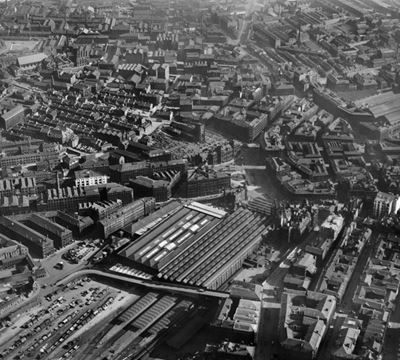
Bradford
Forster Square Station and environs, Bradford, 1928

Bradford
City centre showing construction of Magistrates' Courts, Bradford, 1972

Addingham
The Low Silk Mills, Addingham, 1928
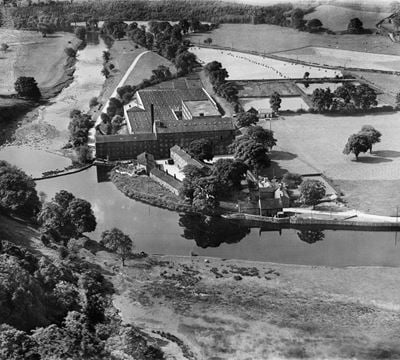
Addingham
Low Mill and the River Wharfe, Addingham, 1932

Shipley
The Henry Mason Ltd Victoria Worsted Works and the Canal Iron Works, Shipley, 1946
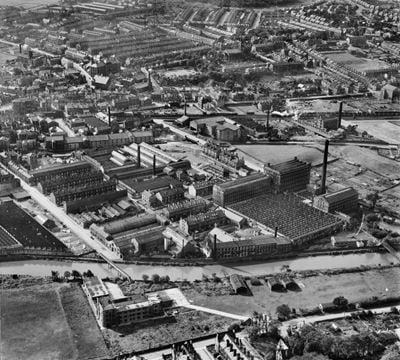
Shipley
The Henry Mason Ltd Victoria Worsted Works and the town, Shipley, 1946

Bolton Woods
Waterhouse, Denbigh and Company quarries, Bradford, 1933
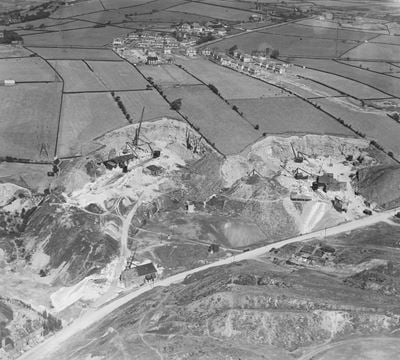
Bolton Woods
Waterhouse, Denbigh and Company quarries, Bradford, 1933
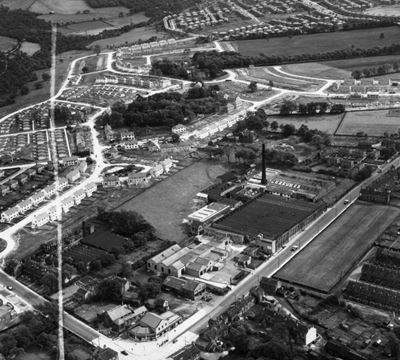
Bradford
Holybrook Mills at Greengates, Bradford, 1948

Bradford
Holybrook Mills at Greengates, Bradford, 1948
Bradford in the Historic England Archive
The Historic England Archive cares for over 15 million images, dating from the 1850s to the present day. Discover stunning images of Bradford's past. Skip this section and go to stories about heritage
Eileen ‘Dusty’ Deste Collection
Great Grough Hole, Oxenhope Moor, Bradford
Date created: 1966 - 1974
The derelict remains of Keeper's Lodge on Oxenhope Moor
John Gay Collection: Counties
Leeming, Bradford
Date created: 1962 - 1966
Detail of low iron railings in the Baptist burial ground at Hawking Stone near Leeming
John Laing Collection
Horton, Bradford, Bradford
Date created: 16 May 1984
Children playing in the playground outside the Horton Park Nursery School (Bradford Children's Centre)
London, Midland and Scottish Railway Company
Bradford
Date created: 10 Apr 1929
Figures standing amongst the stacks of packaged wool on the top floor of the warehouse at Bridge Street Goods Station, with a crane operator at work...
Nigel Temple Collection of Postcards of Parks and Gardens
Little Horton, Bradford, Bradford
Date created: 1900 - 1930
GENERAL VIEW LOOKING TOWARDS THE LAKE AND FOUNTAIN
Walter Scott
Queensbury, Bradford
Date created: 15 Jun 1932
Spectators watching a game of bowls on the green in Russell Hall Park
Eileen ‘Dusty’ Deste Collection
Ingrow, Bradford
Date created: 1966 - 1974
Grove Mills viewed from Halifax Road with the houses of Ash Grove in the foreground
John Laing Collection
Horton, Bradford, Bradford
Date created: 16 May 1984
A view from the south-east of Horton Park Nursery School, now known as Canterbury Children's Centre and Nursery School, showing children playing in...
London, Midland and Scottish Railway Company
Bradford
Date created: 10 Apr 1929
A man stood next to a crane on the top floor of the wool warehouse at Bridge Street Goods Station
Nigel Temple Collection of Postcards of Parks and Gardens
Little Horton, Bradford, Bradford
Date created: 1920 - 1950
GENERAL VIEW LOOKING TOWARDS THE LAKE AND FOUNTAIN
Walter Scott
Queensbury, Bradford
Date created: 15 Jun 1932
Men playing snooker in a hall at an unknown building in Queensbury
Stories about heritage in your local area
Historic England publishes news, blogs, research, videos, and podcasts celebrating England's rich heritage. Discover the stories we have about Bradford. Skip this section and go to education
Historic England in Bradford 2025: Celebrating Heritage, Empowering Youth
Mentions Bradford
As Bradford celebrates, Historic England is working to ensure the benefits of heritage are felt by everyone, and to create a lasting legacy.
A History of Bradford in 10 Places
Mentions Saltaire, Lister Park, Bradford Town Hall
Discover the history of Bradford's buildings including Cartwright Hall, Lister Mills, UNESCO site Saltaire, Bradford Cathedral and Brontë Parsonage...
7 Serene Cemeteries to Visit in England
Mentions Undercliffe Cemetery, Illingworth Mausoleum
These graveyards can offer space for quiet reflection or a peaceful walk.
Narrative Structures: England’s Literary History in 11 Places
Mentions Haworth Parsonage (Bronte Museum)
Discover the historic sites in England where famous writers found their inspiration.
The History of Ukrainians in England
Mentions Ukrainian Autocephalic Orthodox Church, The Ukrainian Catholic Church of Holy Trinity and Our Lady of Pochaiv (formerly St John's Methodist Church)
Ukrainians have influenced several sites across England. Here is a small selection.
How Tutankhamun Influenced 20th Century Design and Architecture
Mentions Illingworth Mausoleum
From the most expensive jewellery and furniture to public buildings, learn now Tutankhamun inspired the world of design and popular culture.
Football, Beerhouses and Books: How Victorian Mill Workers Entertained Themselves
Mentions Roberts Park, Lister Park
The lives of Victorian mill workers were far from easy. So what did they do with their spare time?
5 Post-war Churches That Broke the Mould
Mentions Our Lady and the First Martyrs Catholic Church
Here are five post-war churches that paved the way for how they are built.
Where to Find Egyptian Style Architecture in England
Mentions Illingworth Mausoleum, Undercliffe Cemetery
‘Egyptomania’ was the height of fashion in Regency England. Here are some of the places you can see its impact.
10 Brilliant Historic Bookshops
Mentions Saltaire Mills - Main Block Including Sheds
We love any excuse to celebrate a bookshop, with their comforting atmosphere and wonderful smell. Here are some highlights from around the country.
Connecting People and Places
Mentions Bradford Synagogue (Reform)
A team of aspiring architects have been researching and visiting places of historic interest to BAME communities.
Ee ‘beer’ gum – it’s Yorkshire Day!
Mentions Saltaire Mills - Main Block Including Sheds
This Yorkshire Day we're taking a tour of God’s own county’s beer brewing heritage.
The First 7 UK World Heritage Sites
Mentions Saltaire
Discover the first UK sites to receive UNESCO World Heritage Site listing.
Mentions Bradford
From Sheffield’s Steel to Bradford’s textiles, manufacturing heritage is still a core part of the North’s physical and emotional identity.
Trade of the North | Spirit of the North Ep. 2
From Sheffield’s Steel to Bradford’s textiles, manufacturing heritage is still a core part of the North’s physical and emotional identity. John Kippin explores the places he photographed to reflect the North of England’s trading history.
Mentions Bradford
Picturing High Streets was a 3-year partnership between Historic England and photography champions @photoworks_uk, who worked with 9 regional partner...
How Photography Captured England’s Changing High Streets
Picturing High Streets was a 3-year partnership between Historic England and photography champions @photoworks_uk, who worked with 9 regional partner photography organisations to create a contemporary picture of England’s high streets.
Mentions Bradford
Textile mills once defined the North of England’s landscape. They were the world's workshop from Bolton to Blackburn, Bradford to Leeds.
Mills of the North
Textile mills once defined the North of England’s landscape. They were the world's workshop from Bolton to Blackburn, Bradford to Leeds. Sadly, the North’s historic mills are rapidly being lost.
Historic England in Bradford 2025: Celebrating Heritage, Empowering Youth
Mentions Bradford
As Bradford celebrates, Historic England is working to ensure the benefits of heritage are felt by everyone, and to create a lasting legacy.
To Unpath’d Waters, Undream’d Shores
Mentions Bradford
The Unpath'd Waters project by Historic England aims to connect the UK’s marine and maritime heritage collections through partnership.
Funding for Young People to Explore and Celebrate Their Local History
Mentions Bradford
Historic England has announced new funding for 21 creative youth-led place-marking projects across England.
Funding for Young People in Bradford to Explore and Celebrate Local history
Mentions Bradford
Historic England has announced new funding for 4 creative youth-led projects in Bradford in collaboration with Bradford 2025 UK City of Culture.
£2 Million Awarded to Bradford City Council for Heritage Regeneration Project
Mentions Bradford Town Hall, Bradford
Bradford City Council has been awarded £2 million from Historic England to fund a transformative Heritage Action Zone in the city’s historic core.
Researching Ramsgate
Mentions Bradford
A historic area assessment of Ramsgate and new book supports decision-making on heritage-led regeneration in Ramsgate’s Heritage Action Zone.
Picturing High Streets: Over 200 Images Taken by the Public Enter Historic England Archive
Mentions Bradford
Documenting a year in the life of the English high street, images taken by the public as part of 'Picturing High Streets' can be viewed online.
Unpath’d Waters Demonstrated at Prime Minister’s Council for Science and Technology
Mentions Bradford
Highlighting the economic and cultural impact that a combination of Research & Development (R&D) funding and creative technologies can have in the UK.
Picturing Bradford: Major New Outdoor Photographic Exhibition Opens
Mentions Bradford
A new outdoor photographic exhibition in Bradford captures life on high streets from across the district.
New Heritage Trail Uncovers the History of Bradford
Mentions Bradford
Historic England has created a new heritage trail of Bradford, allowing young people to explore some of the city’s most important historic buildings.
Historic England Celebrates Ukrainian Heritage With New Listings in the North Ahead of Eurovision
Mentions Ukrainian Community Memorial, North Bierley Municipal Cemetery, Bradford, The Ukrainian Catholic Church of Holy Trinity and Our Lady of Pochaiv (formerly St John's Methodist Church), Ukrainian Autocephalic Orthodox Church
Celebrating how the people of Ukraine have helped shape our nation over many generations.
Progress for Peatlands
Mentions Bradford
The historic and natural importance of peatlands with respect to tackling climate change.
Bradford's social history through photos
Over 10,000 images from the Historic England Archive have been specially selected and re-captioned for teachers, students, and anyone who wants to learn more about their local area. Skip this section and go to grant-aided places
Workers housing, 1-22 Ada Street, Saltaire, West Yorkshire
Period: Victorian (1837 - 1901)
Terrace of workers' houses built in 1857 by Lockwood and Mawson for Titus Salt. They are part of Titus Salt's model community - Saltaire.
Workers housing, 1-22 Ada Street, Saltaire, West Yorkshire
Wool sorting, Cumberland Works, Manningham, West Yorkshire
Period: 1980s (1980 - 1989)
Combing is one of the preparatory procedures in wool processing.
Wool sorting, Cumberland Works, Manningham, West Yorkshire
Whetley Mills, Manningham, Bradford, West Yorkshire
Period: Victorian (1837 - 1901)
This illustration is taken from "The Century's Progress", published in 1893.
Whetley Mills, Manningham, Bradford, West Yorkshire
Wells House Hydropathic Establishment, Ilkley, West Yorkshire
Period: Victorian (1837 - 1901)
A view looking onto Wells House Hydropathic Establishment from Barmishaw. The building in the foreground is the water pumping station.
Wells House Hydropathic Establishment, Ilkley, West Yorkshire
Vale Mills, Keighley, West Yorkshire
Period: Georgian (1714 - 1836)
Vale Mills was built as a cotton mill in the early 19th century for John Greenwood and his Son.
Turkey Mill, Keighley West Yorkshire
Period: Georgian (1714 - 1836)
This mill was established in 1797 as a water-powered cotton spinning mill.
Turkey Mill, Keighley West Yorkshire
The Tarn, Ilkley Moor, West Yorkshire
Period: Victorian (1837 - 1901)
The Tarn on the lower part of Ilkley Moor with buildings on Wells Road, Ilkley, just visible in the background.
The Tarn, Ilkley Moor, West Yorkshire
Salt's Mill, Saltaire, Shipley, West Yorkshire
Period: Victorian (1837 - 1901)
Titus Salt was already a wealthy Bradford textile producer when he developed his new mill and model settlement at Saltaire.
Salt's Mill, Saltaire, Shipley, West Yorkshire
Visit grant-aided places near you
These places and buildings have been helped by Historic England's financial grants. Find local heritage in your neighbourhood that you never knew existed! Please note that opening times may vary. Skip this section and go to related locations
Lister Mills, Patent Street, Bradford, West Yorkshire
This mill is the largest and most imposing of Bradford's mills and a major landmark.
Waterloo Mill Engine House, Howden Road, Silsden, Keighley, Bradford, West Yorkshire
The worsted mill's construction commenced between 1867 and 1877 for Charles Hastings and Co, a company of worsted spinners.
Discover more
Ready for more local stories? Take a look at these other places nearby


